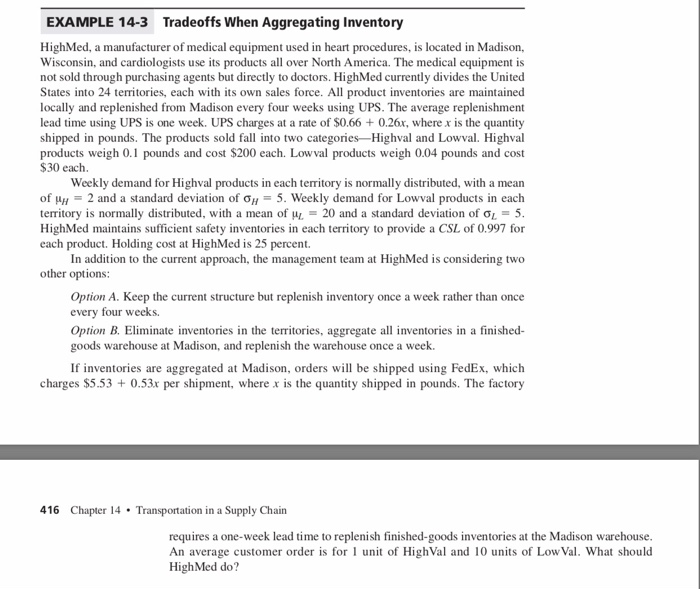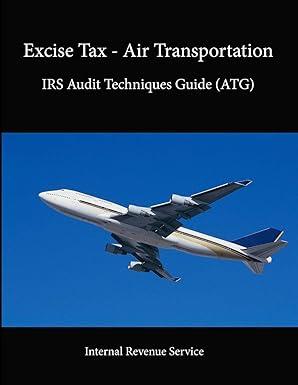please help. thank you

Tradeoffs When Aggregating Inventory EXAMPLE 14-3 HighMed, a manufacturer of medical equipment used in heart procedures, is located in Madison, Wisconsin, and cardiologists use its products all over North America. The medical equipment is not sold through purchasing agents but directly to doctors. HighMed currently divides the United States into 24 territories, each with its own sales force. All product inventories are maintained locally and replenished from Madison every four weeks using UPS. The average replenishment lead time using UPS is one week. UPS charges at a rate of $0.66+ 0.26x, where x is the quantity shipped in pounds. The products sold fall into two categories-Highval and Lowval. Highval products weigh 0.1 pounds and cost $200 each. Lowval products weigh 0.04 pounds and cost $30 each Weekly demand for Highval products in each territory is normally distributed, with a mean of u2 and a stand ard deviation of O 5. Weekly demand for Lowval products in each territory is normally distributed, with a mean of u 20 and a standard deviation of o 5 HighMed maintains sufficient safety inventories in each territory to provide a CSL of 0.997 for each product. Holding cost at HighMed is 25 percent. In addition to the current approach, the management team at HighMed is considering two other options: Option A. Keep the current structure but replenish inventory once a week rather than once every four weeks Option B. Eliminate inventories in the territories, aggregate all inventories in a finished goods warehouse at Madison, and repleni sh the warehouse once a week. If inventories are aggregated at Madison, orders will be shipped using FedEx, which charges $5.53+ 0.53x per shipment, where x is the quantity shipped in pounds. The factory 416 Chapter 14 Transportation in a Supply Chain requires a one-week lead time to repleni sh finished-goods inventories at the Madison warehouse. An average customer order is for 1 unit of HighVal and 10 units of Low Val. What should HighMed do? Tradeoffs When Aggregating Inventory EXAMPLE 14-3 HighMed, a manufacturer of medical equipment used in heart procedures, is located in Madison, Wisconsin, and cardiologists use its products all over North America. The medical equipment is not sold through purchasing agents but directly to doctors. HighMed currently divides the United States into 24 territories, each with its own sales force. All product inventories are maintained locally and replenished from Madison every four weeks using UPS. The average replenishment lead time using UPS is one week. UPS charges at a rate of $0.66+ 0.26x, where x is the quantity shipped in pounds. The products sold fall into two categories-Highval and Lowval. Highval products weigh 0.1 pounds and cost $200 each. Lowval products weigh 0.04 pounds and cost $30 each Weekly demand for Highval products in each territory is normally distributed, with a mean of u2 and a stand ard deviation of O 5. Weekly demand for Lowval products in each territory is normally distributed, with a mean of u 20 and a standard deviation of o 5 HighMed maintains sufficient safety inventories in each territory to provide a CSL of 0.997 for each product. Holding cost at HighMed is 25 percent. In addition to the current approach, the management team at HighMed is considering two other options: Option A. Keep the current structure but replenish inventory once a week rather than once every four weeks Option B. Eliminate inventories in the territories, aggregate all inventories in a finished goods warehouse at Madison, and repleni sh the warehouse once a week. If inventories are aggregated at Madison, orders will be shipped using FedEx, which charges $5.53+ 0.53x per shipment, where x is the quantity shipped in pounds. The factory 416 Chapter 14 Transportation in a Supply Chain requires a one-week lead time to repleni sh finished-goods inventories at the Madison warehouse. An average customer order is for 1 unit of HighVal and 10 units of Low Val. What should HighMed do








